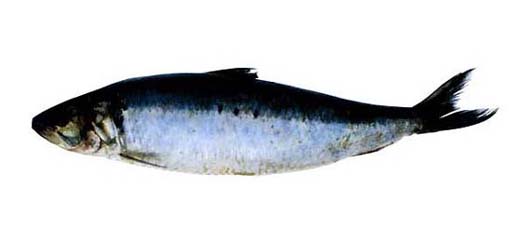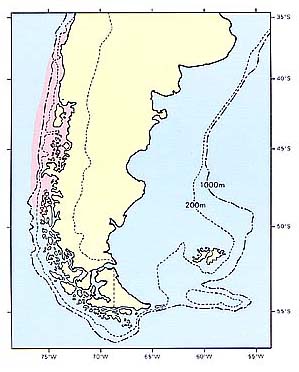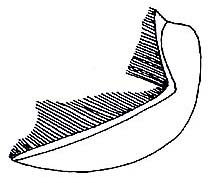ニシン科
- HOME
- デジタル図鑑
- パタゴニア海域の重要水族
- 硬骨魚綱 ニシン目 ニシン科
ニシン科(Clupeidae)

9 ベンティンクニシン(Bentinku-nishin)
Clupea bentincki Norman, 1936
Sardina del Sur, Sardina de invierno (Ch.)
特 徴:
背鰭18軟条,臀鰭16軟条,胸鰭17軟条,腹鰭8軟条,第1鰓弓下枝鰓耙数106,腹部稜鱗数20+14=34。頭長は体長の26.3%,眼径は4.5%,体高は24.8%,吻長は7.2%,両眼間隔は4.9%,上顎長は11.4%,尾柄高は6.9%,胸鰭長は15.0%,腹鰭長は8.2%,背鰭高は11.7%,臀鰭高は4.5%。体は延長しわずかに側扁し,体長は体高の約4倍。吻は中庸で,眼後長の約半分。眼に脂瞼がよく発達する。頭は大きくて,体長は頭長の約4倍。口は斜位で,上顎後端は瞳孔前縁下付近に達する。微小歯が上顎後縁部にあるが,下顎,鋤骨および口蓋骨には歯がない。擬鰓はよく発達する。微小な鋸歯縁を有す鰓耙は第1鰓弓下枝上では中央部で最長,両端で最小,隅角部で高くなり,上枝上では隅角部から遠ざかるにつれて短くなる。胸鰭起部直前の鰓蓋後縁下によく発達した皮弁がある。背鰭は体のほぼ中央にあり,起部は吻端と尾鰭基底との距離の1/2に位置する。胸鰭は下位で,鰓蓋後縁の直後に位置する。腹鰭は小さく,胸鰭の大きさの半分で,起部は背鰭基底の前方から2/3付近下に位置する。胸鰭起部から腹鰭起部に到る距離は腹鰭起部から臀鰭起部に到る距離にほぼ等しい。尾鰭は弱く二叉する。鱗は円鱗で脱落し易い。腹部の稜鱗は弱く,その基底部は丸味を帯びる。背部は暗青色,腹部は銀白色で,各鰭は半透明状を呈する。
分 布:
チリ パタゴニアに広く分布する。
備 考:
中部チリのタルカワーノ地方には多産し,大いに賞味される(Norman, 1937a)とのことであるが,今回の第72あけぼの丸の調査に沿岸域が入っていないせいか,全調査を通じて1尾しか得られなかった。
(稲田伊史)
Material examined:
1 from Chile (283.9 mm SL), FAKU CP 169.
Description:
D 18; A 16; P1 17; P2 8; GR on lower arch 106; Scutes 20+14=34.
HL 26.3% of SL; ED 4.5; BD 24.8; SN 7.2; IO 4.9; UJ 11.4; CP 6.9; P1L 15.0; P2L 8.2; DH 11.7; AH 4.5.
Body elongate and slightly compressed, its depth 4.0 in SL. Snout moderate, about half of postorbital length. Eye covered with thick adipose eyelid. Head rather large, about 3.8 in SL. Mouth oblique, end of maxmilla extending below anterior margin of pupil. Minute teeth on posterior margin of upper jaw. No teeth on lower jaw, vomer palatines. Pseudobranchiae well developed. Gill-rakers with fine serrations; its length longest at middle, becoming shorter on both ends on lower arch and longest at angle, becoming shorter on distal edge on upper arch. Underneath of free edge of gill-cover with developed dermal flap in front of pectoral fin base. Dorsal fin at about middle of body, its origin at middle between snout and caudal fin base. Pectoral fin situated ventrally just behind gill-cover. Pelvic fin small, about half of pectoral fin, situated below two-thirds of dorsal fin base. Length between pectoral fin origin and pelvic fin origin nearly equal to pelvic fin origin to anal fin origin. Caudal fin weakly forked. Scales cycloid and deciduous. Feebly keeled scutes with well developed round bases. Body dark blue dorsally and silvery white ventrally. Fins translucent.
Distribution:
Chilean Patagonia, also known from the Straits of Magellan (Menni, Ringuelet and Aramburu, 1984).
Remarks:
Very common around Talcahuano, central Chile (Norman, 1937a). Bahamonde and Pequeño (1975) recognized subspecies, C. b. bentincki Norman and C. b. cuga de Buen in Chile.
(Izume NAKAMURA)

Distribution of Clupea bentincki in Patagonia.

Gill-rakers on first arch of left side.